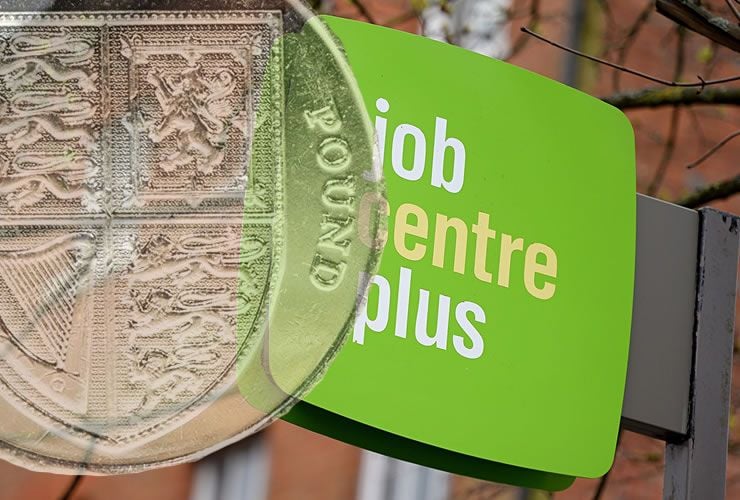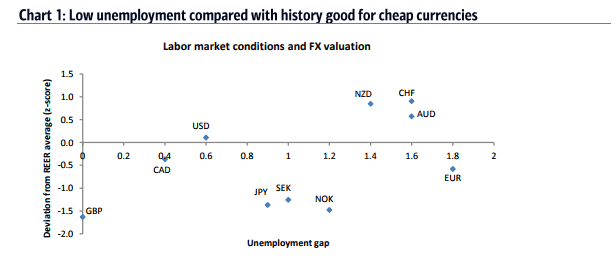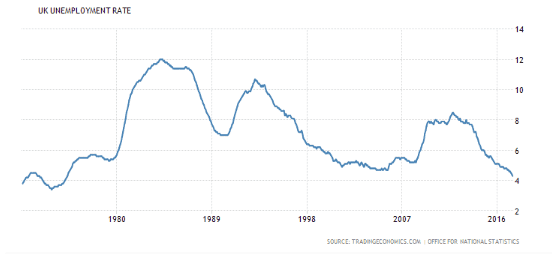The Pound's Shot at Redemption: The UK's Strong Labour Market

Sterling really should be higher - and could indeed go higher - if central banks push forward a newfound trend of focussing on labour markets.
Central bankers are basing their decisions on the strength of the labour market more than inflation, argues a note by Bank of America Merril Lynch.
Recent hawkish rhetoric from central banks in England, Sweden, Norway, Canada and Japan, illustrates the point, as it has been driven largely by extremely low unemployment levels, with little regard given for the equally low inflation levels coexisting in many of these economies.
"G10 Central Banks have started ignoring low inflation and are focusing on labour market tightness instead," says Athanasios Vamvakidis, an FX strategist with Bank of America Merrill Lynch in London.
This was the reason given by many analysts bewildered by the relentlessly hawkish approach of the Federal Reserve, despite data showing a fall in inflation - the Labour market was tight.
Central bankers think that lower unemployment inevitably leads to higher wages, which then lead to higher inflation. The cast iron logic of the argument is difficult to refute.
Yet, strangely enough wages have remained quite low compared to the rate they would be expected given the relatively high levels of employment.
Whilst there are many arguments for why this is so - globalisation, increased automation, more low paid service sector jobs replacing well-paid manufacturing jobs, the discounting effect of the internet etc. The fact remains that wages are not rising as quickly as expected.
Nevertheless, Vamvakidis expects central bankers to look through the correlation breakdown between unemployment and wages and crystal ball gaze higher wages regardless, using that as a rationale for raising interest rates.
This in turn - or the expectation that this will happen - BofA expect will drive up currencies where the labour market is especially tight, indeed this has already been the case with the most recent bout of hawkishness across most of the G10.
"Regardless of whether this new approach proves to be right or not, it has recently moved FX Markets, such as GBP, CAD and USD," says Vamvakidis.
Good News for the Pound
BofA have come up with a graph to illustrate with currencies are the most under or overvalued according to their new criteria.
The chart below compares current levels of unemployment in G10 countries to their historical average and then cross-references it with their REER (Real Effective Exchnage Rate) valuation, a common method use to determine a currencies 'fair value' based on the inflation rate.

Those currencies lieing towards the bottom left hand corner of the chart are undervalued and consequently more likely to rise as they have the lowest levels of employment and are the most undervalued according to their inflation rate - a prime example of which is Sterling, not surprisingly perhaps given the combination of high inflation low unemployment - which is situated in the bottom left hand extreme of the graph.

The least undervalued is the Swiss Franc which lies in the top right hand quadrant of the chart - and also the AUD which is close by.
This leads BofA to recommend buying GBP/CHF.
"Undervalued currencies in tight labour markets should do well," says Vamvakidis, adding:
"Our results are bullish for GBP, SEK, NOK, CAD and JPY against CHF, AUD, NZD, and EUR with the USD in the middle. The strongest signal is for GBP/CHF.
Get up to 5% more foreign exchange by using a specialist provider by getting closer to the real market rate and avoid the gaping spreads charged by your bank for international payments. Learn more here.




